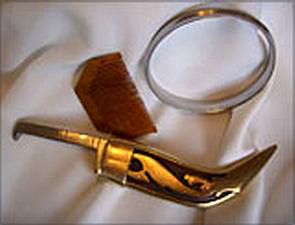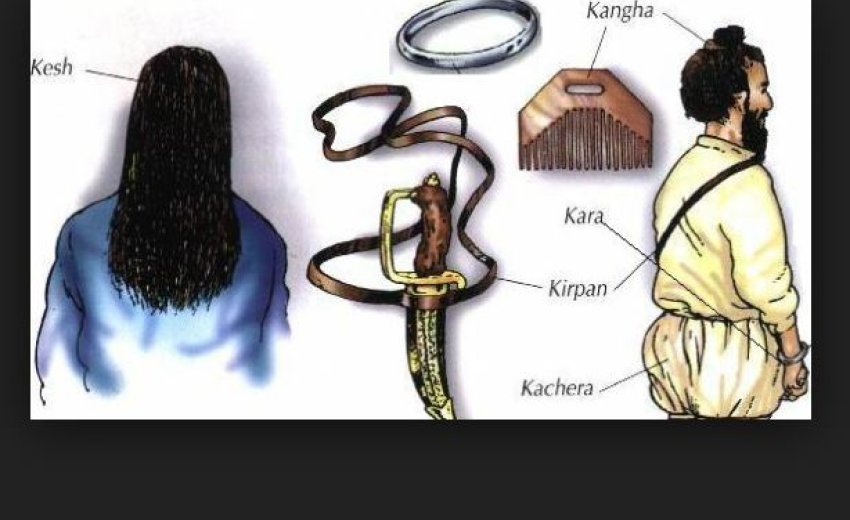THE IRON RING
 I heard a stupid Sikh preacher the other day, trying to convince a mass gathering of his compatriots that the iron ring of the Guru worn off the wrist was a protection against lightning. He said, as large buildings were made safe against lightning by a rod of iron, so the Guru had saved man from the stroke of lightning. He was hopelessly flinging his arms up and down to gather some straw of a reason to prove the rationale of the iron ring, the Guru gave us as a gift. Coming to us from our personal God, dearer to us than our mother, father, sister or sweetheart, it comes to us as His gift, as His blessing. Fie onus that we argue over and over about it. He touched my hair, and I keep it; when I toss my arm up in the air and the iron ring shines, I am reminded of His wrist that wore it - one exactly like this. Is this arm, by some stray gleam of the iron ring on my wrist, His? Other religions live in an elaborated symbolism, I, the Sikh, have no religion. He loved me, He made me His own. The sword is the mind where the Guru lives. The iron ring is the sign of His remembrance.
I heard a stupid Sikh preacher the other day, trying to convince a mass gathering of his compatriots that the iron ring of the Guru worn off the wrist was a protection against lightning. He said, as large buildings were made safe against lightning by a rod of iron, so the Guru had saved man from the stroke of lightning. He was hopelessly flinging his arms up and down to gather some straw of a reason to prove the rationale of the iron ring, the Guru gave us as a gift. Coming to us from our personal God, dearer to us than our mother, father, sister or sweetheart, it comes to us as His gift, as His blessing. Fie onus that we argue over and over about it. He touched my hair, and I keep it; when I toss my arm up in the air and the iron ring shines, I am reminded of His wrist that wore it - one exactly like this. Is this arm, by some stray gleam of the iron ring on my wrist, His? Other religions live in an elaborated symbolism, I, the Sikh, have no religion. He loved me, He made me His own. The sword is the mind where the Guru lives. The iron ring is the sign of His remembrance.
THE MYSTIC HAIR
When the Guru touched my hair and blessed me, how could I bear my hair being shorn? I nestle the fragrance of His touch in my tresses. I am the bride. They, of the modern era, have bobbed the bride, but the Sacred Braids of the Christ still remain the most beautiful adornment of man's or woman's head. The lighting spark is concealed in the wool of the wandering cloud in the sky, and the life-spark of the Guru is hidden in this sheaf of hair. The tresses of hair are as clouds round a showy peak. They always gather, gather, they always rain, rain. In my sacred tresses flows the trinity of the Ganga, the Jamna and the Godavri.
They say, it is troublesome to carry it. But more troublesome is a life of no inspiration. The body itself is not less troublesome. The daily toilet, powder and puff and rouge and the arranging of ear drops and shingles are in no way less troublesome. And when one is reconciled to such a thing as human body,this impossible life, it is emptiness of soul, it is bankruptcy of love for God and for the Guru to think of the riddance of hair, the spiritual crown of humanity. The modern woman has lost most of her soul by shingling her hair and putting an odorous reed in her rosebud-like lips.
The Guru has buried the disciples under heaps of grass. He has concealed His handicraft in thanks of hair. Very irrational, they say. Possibly, very superstitious. Ay! but, I love the Guru's superstition, the Guru's myth. These preserve the life-sparks more effectively than the reason of man. In the fleecy clouds is the lightning. In those hanks of hair, there is the truth of His burning bosom divine. The Christ in his bride braids is certainly more beautiful even as a man, as a woman-born, than any clean-shaven modem face. This machine-like man is far removed from His self, the Great Guru of love.
This seeming superstition of the Guru, in ordering the disciples to preserve their hair unshorn, has in its frailness an abiding depth of truth, giving men some deeper concerns of soul. Thereby, He has precluded the chances of men and women living only for the futile foppishness of sartorial arts or barber-made civilizations. The hair seems redundant to the modem man, but to Guru Gobind Singh, it (the Keshas) was essential for protecting and continuing the antique worthiness of man, and for bringing on of a great moral and religious civilization. His chosen shape of man in the image of the forest and the river and the sky, is like clothing God in the mystery of human form. This shape mellows down the harshness of naked flesh; it limns human life with a divine number by preaching the comely face of the moon. And it is foolish also to preach "hair". We have to preach by our presence if we have cultivated a superior presence. If not, the hair is mere grass, as bones are mere lime. Some people want the Sikhs to shed their identity, but the world would be the poorer for such a thing. A great gift would be denied, a great heritage dishonored.
The working people of the Punjab - the low castes, the sweepers, the laborers, the masons and the farmers - were the first to realize the revolutionary significance of the Guru's injunction. In obeying him, they achieved a new dignity of manhood; they found freedom, they found their lost soul; they realized themselves. By the Guru's touch they became great, noble, alive; and it is they who found that if such a liberator, who has turned the butcher's knife into gold, pure gold, knows what he is saying, the preservation of their personal love for him means that they must wear their hair as the lion his mane. My body is of no consequence to me, I have to live looking at the moon of His face. Those who think of the body are not of the spirit.
Assuredly, without the hair-idea of Guru Gobind Singh, there would have been no Sikh song and life today, except that the Guru Granth would possibly have been another Purana of the Hindus. Taking away the Sikh's hair is to put him off from his intensely reactive inspiration which has been so far a source of strength to the Hindu also. The long hair makes him distinctive; it does not alienate him. The spirit itself would have died without this unkempt exterior. The disappearance of the Sikh as such means the loss of a great national asset of power and inspiration for the Hindu himself. If the disciples of Guru Gobind Singh wish to become great as a political race, great as Walt Whitman says America seemed to be, then they may what they will, but they cease to be His disciples. So the tresses of the Sikhs have preserved in them the Sikh history which everybody else in the Punjab has already forgotten. They are always a source of inspiration to a Sikh. They are an aspect of his deep, soundless gratitude to a Guru who staked his life; nay, his very religion to revive a dead people.
Don't you know these tresses are the wandering waves of the Sea of Illusion? Guru Gobind Singh gathered the waves of the Ocean of Consciousness as the mother gathers the hair of the child. What is man but an Ocean of Consciousness. The Master washed them, combed them and bound them into a knot as the vow of the future manhood which shall know no caste, no distinction between man and man, and which shall work for the peace and amity of all mankind. He who wears His knot of hair is a brother of all men, freed of the ill-feeling of selfishness. He is to be on the point of bayonet, to be of no separatist creed, nor of any national combine of men bent upon loot and plunder and tyranny.
Those who do not yet understand the Law of Love cannot and should not wear the Master's knot of the sacred tresses, and those who do, should wear it as a token of spiritual isolation from the herd. So did Guru Gobind Singh command? And obedience to him is life. There is no life outside that Great Love.
The aim of the Brothers of the Tress-Knot of Guru Gobind Singh is different, different the direction, different their persuasion. Each Sikh wears the hair and the beard of Guru Gobind Singh. We are molded in His own image.
We do not concern ourselves the conditions of life. We grow like flowers in the thorny bed, as also in the bed of velvet moss, for facing the Master and living in Him and breathing Him is our life. And all who desire to be the Brothers of the Tress-Knot of Guru Gobind Singh must live the life of love and not of any other truth. All other truths are of no concern to us. We are now the Sangha of the Tress-Knot of Guru Gobind Singh; our purposes are as inscrutable as those of the God of Destiny.
Such are the dialectics of the Lord-given life! Our truth, unlike that of the old Brahman, is not any mathematical balance of an endless denying of things. Our truth is not a problem solved. Our truth is but a lotus and the bee buzzing about, the cloud and the rain-bird crying for that pearl-like drop of life, the swan and the lake, the child and the mother, the cow and the calf. Our hymns center on these metaphors and all human suffering is vindicated in a moment, even if it be after ages. Meeting the Guru dispels all sorrow, but it is all sorrow without Him. But His absence is also as holy as His presence.
THE SACRED SWORD
 Every Sikh is to wear the Master's Sword. Not his own. Kirpan is a gift from the Guru. It is not an instrument of offence or defense. It is mind made intense by the love of the Guru. The Sikh is to have a sword-like mind. It is the visible sign of an intensely sensitive soul.
Every Sikh is to wear the Master's Sword. Not his own. Kirpan is a gift from the Guru. It is not an instrument of offence or defense. It is mind made intense by the love of the Guru. The Sikh is to have a sword-like mind. It is the visible sign of an intensely sensitive soul.
The sword cuts rapidly, the mind can do so much in an instant. That common-herd mentality with its drolly dullness, with utter incapacity too fly like the Eagles of Heaven cannot live together with the sword of Guru Gobind Singh. It is but the symbol of the myriad personality of the Guru's Sikh that knows no defeat, no disappointment, the personality that is unconquerable in its hope, in its spiritual radiance. Guru Gobind Singh says: "I will make my one dominate over a lakh and a quarter." This dominion is of the illumined mind. The highly intensified and developed intellect naturally becomes overpowering, so much so that it becomes fascinating and attractive in a physical sense.* It gathers its own moths like the intense flame of a night lamp. The presence of a great spiritual man overpowers millions. What is mind if it has not the flash of the lightning and of the sword? All conquests in the battle-field of life are mental and moral: physical conquests are no conquests.
I think he, who wears the Guru's sword, is a spontaneous man fully grown in His spirit. This is to say a great deal. The herd mentality wearing the Guru's sword is as great a mockery as the lightning of oil-lamps in brass-plates before the stone idol of Jagan Nath, against which Guru Nanak sang His famous Aarti. It is no use wearing His sword, if one has not become wholly spiritual, and the animal in man has not shrunk to a petty pet, or, as St. Francis said, 'his ass".
Have I got the Guru's gifts? I may have lost them. But I cannot lose my tresses; I cannot lose my iron ring. I cannot lose my sword. Because, you remember how the Fifth Master called back His disciple, Bhai Gurdas from Benaras. The disciples went as bidden and brought him back with his hands bound with a strung. Once the call of the Master was answered thus. Each one of us is called. We are of His spiritual militia. We have to wear His gifts and we are the prisoners of infinite love. These are the fetters of love, the price of our freedom.
Those who do not have that great personal love for the Guru are still out of court. But our freedom is in Him and not anywhere without Him. Do not talk to us in that strain of the Sikh preacher. These are not the symbols of a religion, not essential rites of any religious discipline. They are the signs of our being "wedded women" They are the wedding gifts from our Master, the bridegroom. He gave all these to us, and they are sacred. Superstitious? Yes, 'but which love hath not and where at all hath love not, its own superstitions?
Submitted by Kulinder Singh

